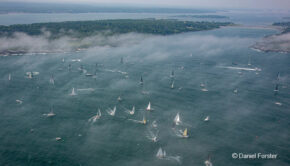A Windliest Bermuda Race
Published on June 24th, 2014
(June 24, 2014) – Jim Grundy says he’s now been a part of the windiest Bermuda Race (1972 with a tropical depression) and the windliest Bermuda Race. Sailing this edition on his Carkeek 47 Grundoom, he leans on a Johnny Cash song to keep his crew tough through the extended calm conditions,
“Son, this world is rough, and if a man’s gonna make it, he’s gotta be tough. It’s the name that helped to make you strong. And I said ‘My name is Sue. How do you do?’”
Joe Harris notes how life on board has settled into a steady routine of trimming, navigating, eating, sleeping and maintaining his Class 40 Gryphon Solo 2. “A pretty simple life, where happiness is driven by having wind and going fast and having no wind and going slow causes a complete psychological re-evaluation. I wish it were that simple on land.”
While finishing well off the record pace of Rambler in 2012 (39:39:18), elapsed winner George Sakellaris’ 72-foot Mini Maxi Shockwave (63:04:11) seemed to suffer less than those in their trail. If there was a key moment, it was when they decided on the second night that the weather had stabilized, and opted not to shoot corners looking for predicted currents or wind, but to play the middle tactically.
Robbie summarized the problem (which is faced by all boats) this way: “When do you stop discussing it and actually head toward Bermuda?” Jibing or tacking on shifts, they caught Bella Mente. Once ahead, Shockwave stayed in front of her all the way to Bermuda.
Despite the forecast for rough weather in the Stream, the most wind Shockwave had was 27 knots while nearing the finish. Most boats have reported a few strong squalls or local winds, and short-lived periods of high boat speed. Steering was relatively simple except when the wind and currents were contrary and stirred up a steep chop.
Doyle noted that the most reliable source of weather information sometimes was not GRIB files or forecasts, but “looking out the window” to study the pattern of clouds, including satellite imagery.
By late Tuesday afternoon, six boats had finished, six boats retired, and 152 still racing. Shockwave, Bella Mente, Caol Ila, and Constellation have finished in the Gibbs Hill Lighthouse Division, while Kodiak and Stark Racing Mad VII have finished in the St. David’s Lighthouse Division.
However, as many as 120 yachts will cross the finish line between sunset Tuesday and sunrise Wednesday morning.
Sources: Race media, Chris Museler, Joe Harris
Background:
The race has five divisions, essentially five separate race fleets:
– Gibbs Hill Lighthouse Division: for professional crews on modern competitive boats
– St. David’s Lighthouse Division: for amateur crews on dual purpose racer-cruiser boats
– Double-handed: only two people on each boat
– Cruiser: for amateur crews on boats not designed for racing
– Open: for boats of a size or construction type beyond the normal range of the fleet









 We’ll keep your information safe.
We’ll keep your information safe.